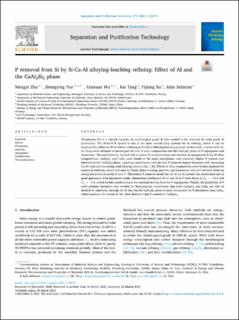P removal from Si by Si-Ca-Al alloying-leaching refining: Effect of Al and the CaAl2Si2 phase
Peer reviewed, Journal article
Published version
Permanent lenke
https://hdl.handle.net/11250/2767498Utgivelsesdato
2021Metadata
Vis full innførselSamlinger
- Publikasjoner fra CRIStin - SINTEF AS [5801]
- SINTEF Industri [1565]
Originalversjon
10.1016/j.seppur.2021.118675Sammendrag
Phosphorus (P) is a critical impurity in metallurgical-grade Si that needed to be removed for solar-grade Si production. The Si-Ca-Al-P system is one of the most crucial alloy systems for Si refining, where P can be separated by either the Si-Al solvent refining or the Si-Ca alloying-leaching process. In this work, a series of Si-Ca-Al alloys were obtained to investigate the role of alloy composition and the CaAl2Si2 phase in P segregation and separation. The used alumina crucible led to heavy Al contamination and resulted in unexpected Si-Ca-Al alloy compositions. CaAl2Si2 and CaSi2 were found as the main precipitates, and relatively higher P content was detected in the CaAl2Si2 phase. Leaching experiments indicate that P removal degree increases with increasing Ca/Al ratio and increasing total alloying amount (Ca + Al). Effects of alloy composition were further analyzed by statistical methods, which indicates Ca firmly plays a strong, positive, and monotonic role in P removal while no strong attraction between Al and P. Theoretical P removal model for the Si-Ca-Al system was established and in good agreement with measured results. Interaction coefficients of Ca and Al to P were fitted as εP_Ca = 19.2 and εP_Al = 1.8,which further confirms Ca is the essential driving force for P segregation. Finally, the possibility of P solid solution formation was verified by first-principle simulations that both CaAl2Si2 and CaSi2 are able to dissolve P, especially through the Si site, but the CaAl2Si2 phase is more favourable for P dissolution than CaSi2, which explains the reason of the often detected high P content in CaAl2Si2.

